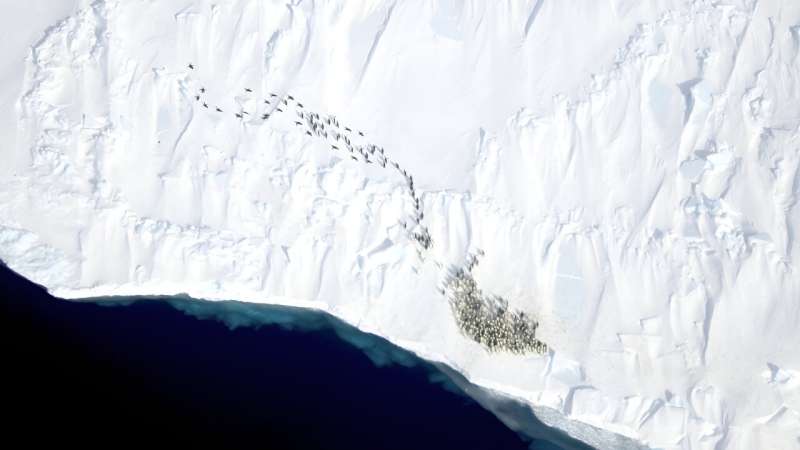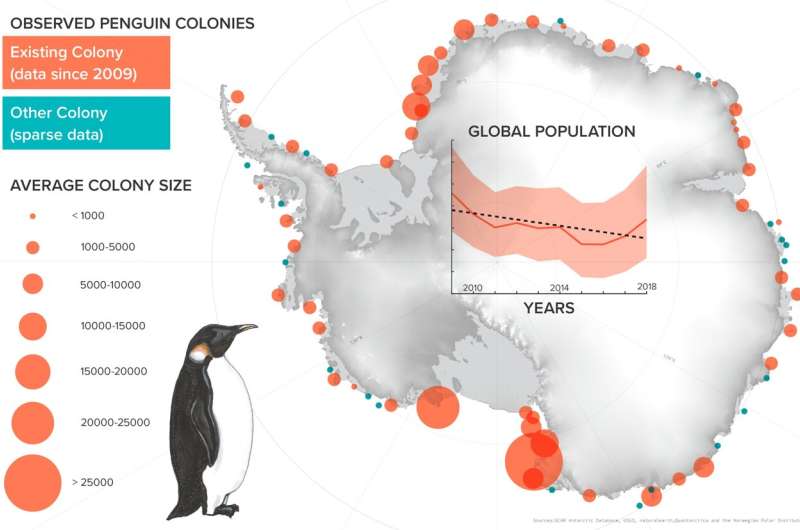This article has been reviewed according to Science X's editorial process and policies. Editors have highlighted the following attributes while ensuring the content's credibility:
fact-checked
trusted source
proofread
High-resolution imagery advances the ability to monitor decadal changes in emperor penguin populations

Emperor penguin populations have been exceedingly difficult to monitor because of their remote locations and because individuals form breeding colonies on seasonal sea ice fastened to land (known as fast ice) during the dark and cold Antarctic winter.
Now, new research that incorporates very high resolution (VHR) satellite imagery with field-based validation surveys and long-term data has provided the first multi-year time series that documents emperor penguin global population trends.
Researchers observed nearly 10% fewer birds in 2018 compared to 2009, according to a new study that used VHR satellite imagery with 30–a 60-centimeter ground resolution to examine the entirety of the penguins' range during springtime around the Antarctic coast.
The research appears in the journal article, "Advances in remote sensing of emperor penguins: first multi-year time series documenting trends in the global population," published in the journal Proceedings of the Royal Society B.
Scientists cannot yet explain the population trend. However, additional research should help with a better understanding of the causal factors—including the role of climate change. Further, this new monitoring methodology could help in the development of adaptive conservation management efforts.

"What we did in this paper, and through international collaborative research, was to develop the state-of-the-art approach to monitoring emperor penguins across all of Antarctica, including in remote places that are inhospitable to people. Having the very high-resolution satellite imagery is a breakthrough in our understanding of the spatial distribution of emperor penguins, and having this global population trend is very important for conservation," said journal article senior author Stephanie Jenouvrier, senior scientist in the Woods Hole Oceanographic Institution's Biology Department.
Jenouvrier noted that computer modeling takes into account many processes and uncertainties related to the penguin population and life history.
"Although we cannot yet clearly attribute this penguin population trend to any particular mechanism such as climate change, there is an accumulation of evidence that the environment is changing, and it does not seem to be an environment where penguins are going to endure," Jenouvrier explained.
The researchers say that the results from the study give them the potential to make more informed predictions by combining monitoring methods and technologies (e.g., field-based and remote sensing). They note that these will require evaluation of assumptions regarding observation and data processing errors.
"Our work documents change in an iconic polar seabird and shows how useful remote sensing can be to understand animals that live in wild places," according to journal article co-lead author Michelle LaRue, who is an associate professor at the University of Canterbury in New Zealand and research associate at the University of Minnesota Twin Cities in the United States.
"In a rapidly changing world, we have to constantly push the envelope to combine new approaches with tried-and-true methods if we want to understand the consequences of that change, especially in places we cannot get to."
LaRue said combining satellite images with animal tracking, ground observations, and molecular tools (like genetic analysis) will be needed if they want to fully understand mechanisms to describe some of the changes they observe.
During the course of the study, researchers detected several new colonies, bringing the total to 66 known colony locations. It is now highly probable that most emperor penguin colony locations have been detected, with about half having been detected with satellite imagery, according to the paper.
In addition, the research identified the East Indian Ocean and Weddell Sea areas of Antarctica as being the two sectors of the continent where there is the greatest probability of declines in regional populations of emperor penguins. These are locations where the extent of fast ice generally has decreased in recent decades. Emperor penguins primarily form colonies and rear their chicks on fast ice.
"We don't understand the population trend in full, and we need to do more research. However, the fact that we have detected a population trend in such a short data set is really important because it potentially has major implications for the future of the species," said journal article co-author Philip Trathan, an emeritus fellow with the British Antarctic Survey where he previously was head of conservation ecology.
"Projections indicate that emperor penguins are going to be struggling to survive into the future. So, having tools that allow us to ground truth some of the population models in the future will be really important."
The journal article authors said that with this new methodology, there is now a way forward to assess the population status and trends of emperor penguins at a global scale, which provides an invaluable tool for adaptive conservation planning in the changing Southern Ocean.
More information: Michelle LaRue et al, Advances in remote sensing of emperor penguins: first multi-year time series documenting trends in the global population, Proceedings of the Royal Society B: Biological Sciences (2024). DOI: 10.1098/rspb.2023.2067
Provided by Woods Hole Oceanographic Institution




















